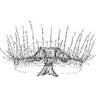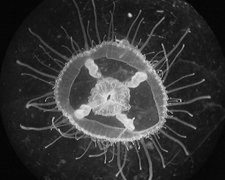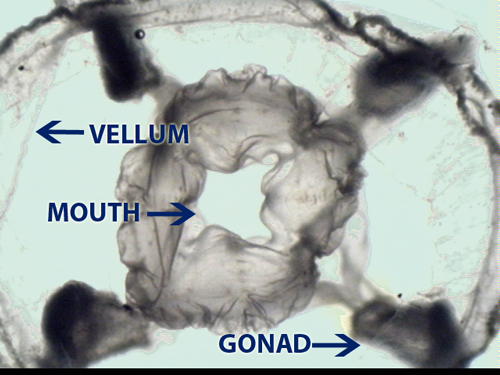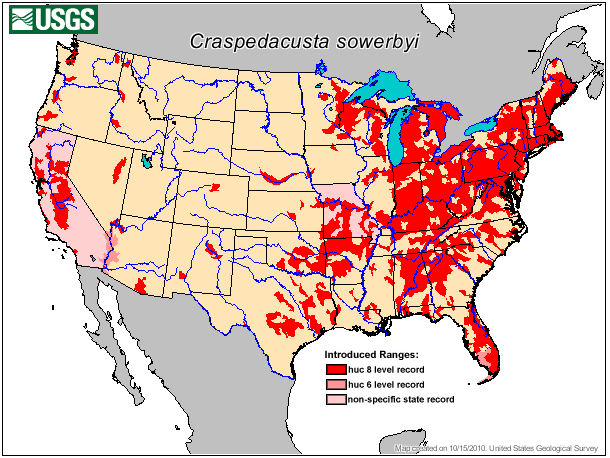|
|
Zooplankton
of the Great Lakes
Site
configuration by: David Branson
Organism: Craspedacusta sowerbyi"Freshwater Jellyfish"
|
||||
|
Picture (http://www.freshwaterjellyfish.org/picture11.html) Classification:
History: Craspedacusta sowerbyi Lankester was first described in 1880 in England by Lankester. After Lankester's initial description it has been identified in North and South America, Asia, Europe and Australia. C. sowerbyi is one of three species of the Genus Craspedacusta in the Family Olindiidae. C. sowerbyi is commonly referred to a freshwater jellyfish but is not actaully in the same class as true jellies.
Anatomy: C. sowerbyi has 2 distinct forms, an asexual polyploid form and a sexual hydromedusa form.
Hydormedusa: (See Fig 1) The mature hydromedusa measures 20-25 mm in diameter, and is translucent with a whitish or greenish tinge. It possesses a gastrovascular cavity formed by five canals. Four are radial with gonads at the terminal ends and one is medially dorsoventral formed by the manubrium and oral opening or mouth. Numerous tentacles of varying lengths protrude from the upper margin of the velum. The tentacles contain thousands of cells called cnidocytes, which contain nematocysts. The nematocysts forcefully penetrate the skin of prey and deliver a neurotoxin which immobilizes the prey. The tentacles then move the prey to the oral opening and after digestion the waste is expelled through the same opening (Acker and Acker 1976).
Polyploid: A polyp has a cap(capitulum) with nematocysts and an oral opening, with a thin region, ending in a rounder base which attaches to substrates. Approximate length is about 1mm but the polyp can contract to half it's size and may expand to almost double. Polyps exhibit 3 asexual reproduction methods. Polyps can exist as single entities or in budded colonies (Bushnell and Bushnell 1967).
Feeding: Hydromedusa: The medusa have been shown to ingest various zooplankton ranging in size from 0.1-3.0mm with larger active prey being preferred (Spadinger and Maier 1999). With smaller prey, spacing of the tentacles may be a factor in prey selection and the smaller prey may be too slow or small to activate the nematocysts(Spadinger and Maier 1999). Polyp: The polyp also uses nematocycts in its capitulum to immobilze prey, taking prey many times their size (Bushnell and Bushnell 1967). Observations of multiple polyps in a colony feeding on the same prey have been observed as well (Bushnell and Bushnell 1967). Distribution:(See Fig 3) C. sowerbyi is thought to be invasive to areas outside of China, because it is usually identified in artificial water bodies first outside of the Yangtze River system. It was likely transported in polyp form on aquatic plant exports (Bushnell and Porter 1967). It has been Identified in Asia, North and South America, Europe, Africa and Australia. C. sowerbyi was first reported in the state of Michigan in 1933 (Bushnell and Porter 1967) It has since been recorded throughout the region including in Lake Huron and Lake St. Clair (USGS 2009). Lifecycle: Asexual:The polyp form exhibits three asexual reproduction methods: 1. Budding one or more new polyps, near the base, forming a colony. 2. Budding a frustule, which is a motile body with no oral opening. The frustule moves a short distance, attaches itself to the substrate and differentiates into a polyp 3. Budding of hydromedusa. The buds grow on the side of the polyp until it is considerably larger than the polyp itself releasing into the water as a sexually immature medusae. (Bushnell and Bushnell 1967) Sexual: The "jellyfish" or hydromedusa reproduce sexually. Males release sperm into the water and females release eggs. Fertilized eggs develop into planula larvae which eventually settle to the bottom of the pond or lake and develop into polyps. In the United States, most populations of jellyfish are all male or all female, so sexual reproduction may be rare (Peard 2005).
|
Fig 1
Fig 2 (http://michiganscienceart.com/)
Fig 3 http://nas.er.usgs.gov/queries/FactSheet.aspx?speciesID=1068
Fig 4 (http://freshwaterjellyfish.org/)
|
||||
Works Cited:
Acker, T. S. and A. M. M. (1976). “The Ecology of Craspedacusta sowerbii Lankester, a Freshwater Hydrozoan.” The American Midland Naturalist 95(2): 323-336. Bushnell, J. H. J. and T. W. P. (1967). “The Occurrence, Habitat, Prey, of Craspedacusta sowerbii in Michigan.” Trans. American Microsc. Soc. 86(1): 22-27. Spadinger, R. and Maier, G. (1999), Prey selection and diel feeding of the freshwater jellyfish, Craspedacusta sowerbyi. Freshwater Biology, 41: 567–573. doi: 10.1046/j.1365-2427.1999.00408.x Peard, T. (2005). Natural History of the the freshwater jellyfish. Retrieved October 12, 2009 from Freshwater Jellyfish website: http://freshwaterjellyfish.org/ McKercher L., O'Connell D., Fuller P., and Liebig J. (2009) Craspedacusta sowerbyi Factsheet. Retrieved October 12, 2009, from USGS Website: http://nas.er.usgs.gov/queries/FactSheet.aspx?speciesID=1068 |
|||||






